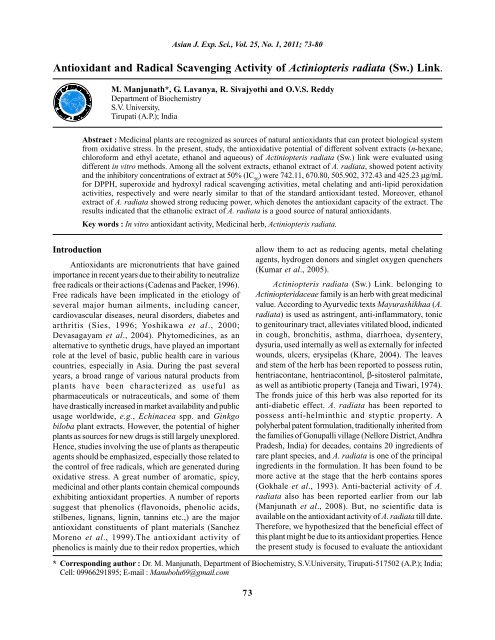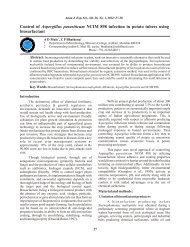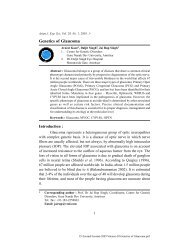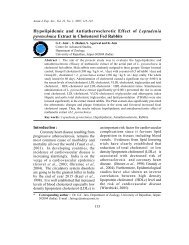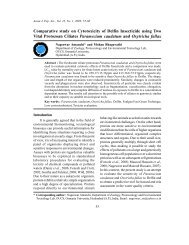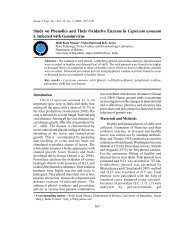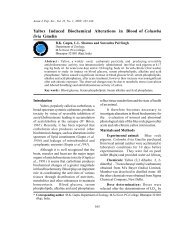Antioxidant and Radical Scavenging Activity of Actiniopteris ... - Ajes.in
Antioxidant and Radical Scavenging Activity of Actiniopteris ... - Ajes.in
Antioxidant and Radical Scavenging Activity of Actiniopteris ... - Ajes.in
Create successful ePaper yourself
Turn your PDF publications into a flip-book with our unique Google optimized e-Paper software.
Asian J. Exp. Sci., Vol. 25, No. 1, 2011; 73-80<br />
<strong>Antioxidant</strong> <strong>and</strong> <strong>Radical</strong> <strong>Scaveng<strong>in</strong>g</strong> <strong>Activity</strong> <strong>of</strong> <strong>Act<strong>in</strong>iopteris</strong> radiata (Sw.) L<strong>in</strong>k.<br />
M. Manjunath*, G. Lavanya, R. Sivajyothi <strong>and</strong> O.V.S. Reddy<br />
Department <strong>of</strong> Biochemistry<br />
S.V. University,<br />
Tirupati (A.P.); India<br />
Abstract : Medic<strong>in</strong>al plants are recognized as sources <strong>of</strong> natural antioxidants that can protect biological system<br />
from oxidative stress. In the present, study, the antioxidative potential <strong>of</strong> different solvent extracts (n-hexane,<br />
chlor<strong>of</strong>orm <strong>and</strong> ethyl acetate, ethanol <strong>and</strong> aqueous) <strong>of</strong> <strong>Act<strong>in</strong>iopteris</strong> radiata (Sw.) l<strong>in</strong>k were evaluated us<strong>in</strong>g<br />
different <strong>in</strong> vitro methods. Among all the solvent extracts, ethanol extract <strong>of</strong> A. radiata, showed potent activity<br />
<strong>and</strong> the <strong>in</strong>hibitory concentrations <strong>of</strong> extract at 50% (IC 50<br />
) were 742.11, 670.80, 505.902, 372.43 <strong>and</strong> 425.23 µg/mL<br />
for DPPH, superoxide <strong>and</strong> hydroxyl radical scaveng<strong>in</strong>g activities, metal chelat<strong>in</strong>g <strong>and</strong> anti-lipid peroxidation<br />
activities, respectively <strong>and</strong> were nearly similar to that <strong>of</strong> the st<strong>and</strong>ard antioxidant tested. Moreover, ethanol<br />
extract <strong>of</strong> A. radiata showed strong reduc<strong>in</strong>g power, which denotes the antioxidant capacity <strong>of</strong> the extract. The<br />
results <strong>in</strong>dicated that the ethanolic extract <strong>of</strong> A. radiata is a good source <strong>of</strong> natural antioxidants.<br />
Key words : In vitro antioxidant activity, Medic<strong>in</strong>al herb, <strong>Act<strong>in</strong>iopteris</strong> radiata.<br />
Introduction<br />
<strong>Antioxidant</strong>s are micronutrients that have ga<strong>in</strong>ed<br />
importance <strong>in</strong> recent years due to their ability to neutralize<br />
free radicals or their actions (Cadenas <strong>and</strong> Packer, 1996).<br />
Free radicals have been implicated <strong>in</strong> the etiology <strong>of</strong><br />
several major human ailments, <strong>in</strong>clud<strong>in</strong>g cancer,<br />
cardiovascular diseases, neural disorders, diabetes <strong>and</strong><br />
arthritis (Sies, 1996; Yoshikawa et al., 2000;<br />
Devasagayam et al., 2004). Phytomedic<strong>in</strong>es, as an<br />
alternative to synthetic drugs, have played an important<br />
role at the level <strong>of</strong> basic, public health care <strong>in</strong> various<br />
countries, especially <strong>in</strong> Asia. Dur<strong>in</strong>g the past several<br />
years, a broad range <strong>of</strong> various natural products from<br />
plants have been characterized as useful as<br />
pharmaceuticals or nutraceuticals, <strong>and</strong> some <strong>of</strong> them<br />
have drastically <strong>in</strong>creased <strong>in</strong> market availability <strong>and</strong> public<br />
usage worldwide, e.g., Ech<strong>in</strong>acea spp. <strong>and</strong> G<strong>in</strong>kgo<br />
biloba plant extracts. However, the potential <strong>of</strong> higher<br />
plants as sources for new drugs is still largely unexplored.<br />
Hence, studies <strong>in</strong>volv<strong>in</strong>g the use <strong>of</strong> plants as therapeutic<br />
agents should be emphasized, especially those related to<br />
the control <strong>of</strong> free radicals, which are generated dur<strong>in</strong>g<br />
oxidative stress. A great number <strong>of</strong> aromatic, spicy,<br />
medic<strong>in</strong>al <strong>and</strong> other plants conta<strong>in</strong> chemical compounds<br />
exhibit<strong>in</strong>g antioxidant properties. A number <strong>of</strong> reports<br />
suggest that phenolics (flavonoids, phenolic acids,<br />
stilbenes, lignans, lign<strong>in</strong>, tann<strong>in</strong>s etc.,) are the major<br />
antioxidant constituents <strong>of</strong> plant materials (Sanchez<br />
Moreno et al., 1999).The antioxidant activity <strong>of</strong><br />
phenolics is ma<strong>in</strong>ly due to their redox properties, which<br />
allow them to act as reduc<strong>in</strong>g agents, metal chelat<strong>in</strong>g<br />
agents, hydrogen donors <strong>and</strong> s<strong>in</strong>glet oxygen quenchers<br />
(Kumar et al., 2005).<br />
<strong>Act<strong>in</strong>iopteris</strong> radiata (Sw.) L<strong>in</strong>k. belong<strong>in</strong>g to<br />
Act<strong>in</strong>iopteridaceae family is an herb with great medic<strong>in</strong>al<br />
value. Accord<strong>in</strong>g to Ayurvedic texts Mayurashikhaa (A.<br />
radiata) is used as astr<strong>in</strong>gent, anti-<strong>in</strong>flammatory, tonic<br />
to genitour<strong>in</strong>ary tract, alleviates vitilated blood, <strong>in</strong>dicated<br />
<strong>in</strong> cough, bronchitis, asthma, diarrhoea, dysentery,<br />
dysuria, used <strong>in</strong>ternally as well as externally for <strong>in</strong>fected<br />
wounds, ulcers, erysipelas (Khare, 2004). The leaves<br />
<strong>and</strong> stem <strong>of</strong> the herb has been reported to possess rut<strong>in</strong>,<br />
hentriacontane, hentriacont<strong>in</strong>ol, β-sitosterol palmitate,<br />
as well as antibiotic property (Taneja <strong>and</strong> Tiwari, 1974).<br />
The fronds juice <strong>of</strong> this herb was also reported for its<br />
anti-diabetic effect. A. radiata has been reported to<br />
possess anti-helm<strong>in</strong>thic <strong>and</strong> styptic property. A<br />
polyherbal patent formulation, traditionally <strong>in</strong>herited from<br />
the families <strong>of</strong> Gonupalli village (Nellore District, Andhra<br />
Pradesh, India) for decades, conta<strong>in</strong>s 20 <strong>in</strong>gredients <strong>of</strong><br />
rare plant species, <strong>and</strong> A. radiata is one <strong>of</strong> the pr<strong>in</strong>cipal<br />
<strong>in</strong>gredients <strong>in</strong> the formulation. It has been found to be<br />
more active at the stage that the herb conta<strong>in</strong>s spores<br />
(Gokhale et al., 1993). Anti-bacterial activity <strong>of</strong> A.<br />
radiata also has been reported earlier from our lab<br />
(Manjunath et al., 2008). But, no scientific data is<br />
available on the antioxidant activity <strong>of</strong> A. radiata till date.<br />
Therefore, we hypothesized that the beneficial effect <strong>of</strong><br />
this plant might be due to its antioxidant properties. Hence<br />
the present study is focused to evaluate the antioxidant<br />
* Correspond<strong>in</strong>g author : Dr. M. Manjunath, Department <strong>of</strong> Biochemistry, S.V.University, Tirupati-517502 (A.P.); India;<br />
Cell: 09966291895; E-mail : Manubolu69@gmail.com<br />
73
Asian J. Exp. Sci., Vol. 25, No. 1, 2011; 73-80<br />
potential <strong>of</strong> the A. radiata by employ<strong>in</strong>g various <strong>in</strong> vitro<br />
models.<br />
Materials <strong>and</strong> Methods<br />
Chemicals<br />
L-Ascorbic acid, quercet<strong>in</strong>, gallic acid, 2, 2-<br />
diphenyl-1-picrylhydrazyl (DPPH) was purchased from<br />
Sigma Chemical Co. (St Louis, MO, USA). Potassium<br />
ferricyanide, ethylene-diam<strong>in</strong>e-tetra acetic acid (EDTA),<br />
nitro blue tetrazolium (NBT), phenaz<strong>in</strong>e methosulphate<br />
(PMS), nicot<strong>in</strong>amide aden<strong>in</strong>e d<strong>in</strong>ucleotide (NADH),<br />
thiobarbituric acid (TBA), trichloroacetic acid (TCA),<br />
2-deoxy ribose, ammonium thiocyanate <strong>and</strong> ferric<br />
chloride were purchased from Hi-media Chemical Co.<br />
Mumbai, India. All other chemicals <strong>and</strong> reagents used<br />
were <strong>of</strong> analytical grade.<br />
Plant material <strong>and</strong> extraction<br />
A. radiata were collected from <strong>in</strong> & around<br />
Tirumala Hills, Andhra Pradesh, India <strong>and</strong> authenticated<br />
through Department <strong>of</strong> Botany, Sri Venkateswara<br />
University, Tirupati. One hundred gram <strong>of</strong> the air dried<br />
<strong>and</strong> powdered A. radiata whole herb were extracted<br />
with hexane first. The rema<strong>in</strong><strong>in</strong>g material was dried <strong>and</strong><br />
extracted with chlor<strong>of</strong>orm; <strong>in</strong> a similar way extraction<br />
with ethyl acetate <strong>and</strong> then with ethanol was performed<br />
for 10 hr us<strong>in</strong>g soxhlet apparatus (Suffness <strong>and</strong> Douros,<br />
1979). The solvents were completely evaporated at 40ºC<br />
us<strong>in</strong>g a rotary vacuum evaporator. The residues were<br />
designated as hexane extract, chlor<strong>of</strong>orm extract, ethyl<br />
acetate extract <strong>and</strong> ethanol extract (HEAR, ChEAR,<br />
EaEAR <strong>and</strong> EEAR respectively). The rema<strong>in</strong><strong>in</strong>g material<br />
after solvent extraction was suspended <strong>in</strong> 1 L distilled<br />
water <strong>and</strong> boiled for 1h at 90-95 o C. The supernatant<br />
removed <strong>and</strong> the extraction was repeated once aga<strong>in</strong>.<br />
The supernatants thus obta<strong>in</strong>ed were comb<strong>in</strong>ed <strong>and</strong><br />
filtered through Whatmann No.1 filter paper. The filtrate<br />
was concentrated at low temperature <strong>and</strong> f<strong>in</strong>ally the<br />
concentrate was lyophilized. The residue was designated<br />
as aqueous extract (AEAR). The samples were stored<br />
at 4 o C <strong>and</strong> used for studies.<br />
Assay <strong>of</strong> Lipid peroxidation<br />
Lipid peroxidation (LPO) was <strong>in</strong>duced by Fe 2+ -<br />
ascorbate system <strong>in</strong> human red blood cells (RBC) <strong>and</strong><br />
estimated as thiobarbituric acid react<strong>in</strong>g substances<br />
(TBARS) by Buege <strong>and</strong> Aust method (Buege <strong>and</strong> Aust,<br />
1978). The reaction mixture conta<strong>in</strong>ed RBC packed cell<br />
(10 8 cells/mL) washed <strong>in</strong> Tris-HCl buffer (20mM, pH<br />
7.0) with CuCl 2<br />
(2mM), ascorbic acid (10mM) <strong>and</strong><br />
different concentrations <strong>of</strong> hexane, chlor<strong>of</strong>orm,<br />
ethylacetate, ethanol <strong>and</strong> aqueous extracts <strong>of</strong> A. radiata<br />
(200-1000 µg/ mL) at f<strong>in</strong>al volume (1mL). The reaction<br />
mixture was <strong>in</strong>cubated at 37 o C for 1 hr. Lipid<br />
peroxidation was measured as malondialdehyde (MDA)<br />
equivalent us<strong>in</strong>g trichloroacetic acid (TCA),<br />
thiobarbituric acid (TBA) <strong>and</strong> HCl (TBA-TCA reagent:<br />
0.375% w/v TBA, 15%w/v TCA <strong>and</strong> 0.25N HCl)<br />
(Halliwell et al.,1987). The <strong>in</strong>cubated reaction mixture<br />
was mixed with 2 mL <strong>of</strong> TBA-TCA reagent <strong>and</strong> heated<br />
<strong>in</strong> a boil<strong>in</strong>g water bath for 15 m<strong>in</strong>. After cool<strong>in</strong>g the<br />
flocculants precipitate was removed by centrifugation<br />
at 1000g for 10 m<strong>in</strong>. F<strong>in</strong>ally malondialdehyde<br />
concentration <strong>in</strong> the supernatant fraction was determ<strong>in</strong>ed<br />
spectrophotometrically at 535nm. Ascorbic acid was<br />
used as st<strong>and</strong>ard.<br />
Determ<strong>in</strong>ation <strong>of</strong> DPPH radical scaveng<strong>in</strong>g<br />
activity<br />
The free radical scaveng<strong>in</strong>g activity <strong>of</strong> the plant<br />
extracts <strong>and</strong> ascorbic acid was measured by Blois<br />
method (Blois, 1958). 0.1 mM solution <strong>of</strong> the stable<br />
radical DPPH <strong>in</strong> ethanol was prepared <strong>and</strong> 1 mL <strong>of</strong> this<br />
solution was added to 3 mL <strong>of</strong> plant extract solutions <strong>in</strong><br />
water at different concentrations (200-1000 ìg/ mL).<br />
Thirty m<strong>in</strong>utes later, the absorbance was measured at<br />
517 nm. Lower absorbance <strong>of</strong> the reaction mixture<br />
<strong>in</strong>dicates higher free radical scaveng<strong>in</strong>g activity. The<br />
capability to scavenge the DPPH radical was calculated<br />
us<strong>in</strong>g the follow<strong>in</strong>g equation:<br />
(A<br />
DPPH Scavenged(%) =<br />
− A<br />
A<br />
cont<br />
)<br />
cont test<br />
×<br />
100<br />
Where A cont<br />
is the absorbance <strong>of</strong> the control<br />
reaction <strong>and</strong> A test<br />
is the absorbance <strong>in</strong> the presence <strong>of</strong><br />
the sample <strong>of</strong> the extracts.<br />
Determ<strong>in</strong>ation <strong>of</strong> superoxide anion radical<br />
scaveng<strong>in</strong>g activity<br />
Measurement <strong>of</strong> superoxide anion scaveng<strong>in</strong>g<br />
activity <strong>of</strong> the hexane, chlor<strong>of</strong>orm, ethylacetate, ethanol<br />
<strong>and</strong> aqueous extracts <strong>of</strong> A. radiata was based on the<br />
method described by Liu et al. (1997) with slight<br />
modification. Superoxide radicals are generated <strong>in</strong> PMS-<br />
NADH systems by oxidation <strong>of</strong> NADH <strong>and</strong> assayed by<br />
the reduction <strong>of</strong> nitro blue tetrazolium (NBT). In this<br />
experiment, the superoxide radicals were generated <strong>in</strong><br />
3.0 mL <strong>of</strong> Tris-HCl buffer (16mM, pH 8.0) conta<strong>in</strong><strong>in</strong>g<br />
1 mL <strong>of</strong> NBT (50 ìM) solution, 1 mL NADH (78ìM)<br />
solution <strong>and</strong> a sample solution <strong>of</strong> plant extracts (200-<br />
1000 ìg/mL) <strong>in</strong> water. The reaction started by add<strong>in</strong>g 1<br />
mL <strong>of</strong> phenaz<strong>in</strong>e methosulphate (PMS) solution (10 ìM)<br />
to the mixture. The reaction mixture was <strong>in</strong>cubated at<br />
74
100°C for 5 m<strong>in</strong>, <strong>and</strong> the absorbance at 560 nm was<br />
measured aga<strong>in</strong>st blank samples. L-ascorbic acid was<br />
used as a st<strong>and</strong>ard. Decreased absorbance <strong>of</strong> the reaction<br />
mixture <strong>in</strong>dicates <strong>in</strong>creased super oxide anion scaveng<strong>in</strong>g<br />
activity. The % <strong>in</strong>hibition <strong>of</strong> superoxide anion generation<br />
by the extract was calculated us<strong>in</strong>g the formula, as stated<br />
<strong>in</strong> the methodology <strong>of</strong> DPPH radical scaveng<strong>in</strong>g activity.<br />
Evaluation <strong>of</strong> the hydroxyl radical scaveng<strong>in</strong>g<br />
activity<br />
Hydroxyl radical scaveng<strong>in</strong>g activity was carried<br />
out by measur<strong>in</strong>g the competition between deoxyribose<br />
<strong>and</strong> the extract for hydroxyl radicals generated from<br />
the Fe 3+ /ascorbate/EDTA/H 2<br />
O 2<br />
system. Attack <strong>of</strong> the<br />
hydroxyl radical on deoxyribose led to TBARS<br />
(thiobarbituric acid-reactive substances) formation<br />
(Halliwell <strong>and</strong> Gutteridge, 1981). The formed TBARS<br />
were measured by given by Ohkawa method (Ohkawa<br />
et al., 1979). Different concentrations <strong>of</strong> hexane,<br />
chlor<strong>of</strong>orm, ethylacetate, ethanol <strong>and</strong> aqueous extracts<br />
<strong>of</strong> A. radiata (200-1000 µg/ mL) were added to the<br />
reaction mixture conta<strong>in</strong><strong>in</strong>g 2.8 mmol L –1 deoxyribose,<br />
100 µmol L –1 FeCl 3<br />
, 104 µmol L –1 EDTA, 100 µmol L –1<br />
ascorbic acid, 1 mmol L –1 H 2<br />
O 2<br />
<strong>and</strong> 230 mmol L –1<br />
phosphate buffer (pH 7.4), mak<strong>in</strong>g a f<strong>in</strong>al volume <strong>of</strong><br />
1.0 mL. 1 mL <strong>of</strong> thiobarbituric acid TBA (1%) <strong>and</strong> 1.0<br />
mL trichloroacetic acid (TCA 2.8%) were added to the<br />
test tube <strong>and</strong> <strong>in</strong>cubated at 100°C for 20 m<strong>in</strong>. After<br />
cool<strong>in</strong>g, absorbance was measured at 532 nm aga<strong>in</strong>st a<br />
blank conta<strong>in</strong><strong>in</strong>g deoxyribose <strong>and</strong> buffer. Reactions were<br />
carried out <strong>in</strong> triplicate. In the series <strong>of</strong> control<br />
experiments, reference compound, ascorbic acid (100<br />
µg mL –1 <strong>in</strong> phosphate buffer pH 7.4) was used <strong>in</strong>stead<br />
<strong>of</strong> the extract solution. The reaction mixture was<br />
<strong>in</strong>cubated at 37°C for 1 hr. The capability <strong>of</strong> the extract<br />
to scavenge hydroxyl radical was calculated, us<strong>in</strong>g the<br />
above stated formula.<br />
Metal chelat<strong>in</strong>g activity on ferrous ions<br />
The chelat<strong>in</strong>g effect <strong>of</strong> ferrous ions by hexane,<br />
chlor<strong>of</strong>orm, ethylacetate, ethanol <strong>and</strong> aqueous extracts<br />
<strong>of</strong> A. radiata <strong>and</strong> st<strong>and</strong>ards were estimated by D<strong>in</strong>is<br />
method (D<strong>in</strong>is et al., 1994). Briefly, different<br />
concentrations <strong>of</strong> hexane, chlor<strong>of</strong>orm, ethylacetate,<br />
ethanol <strong>and</strong> aqueous extracts <strong>of</strong> A. radiata (200-1000<br />
µg/ mL) were added to a solution <strong>of</strong> 2mM FeCl 2<br />
(0.05<br />
mL).The reaction was <strong>in</strong>itiated by the addition <strong>of</strong> 5mM<br />
ferroz<strong>in</strong>e (0.2 mL) <strong>and</strong> the mixture was shaken<br />
vigorously <strong>and</strong> left st<strong>and</strong><strong>in</strong>g at room temperature for 10<br />
m<strong>in</strong>utes. Then, the absorbance <strong>of</strong> the solution was<br />
measured spectrophotometrically at 562 nm. EDTA was<br />
used as st<strong>and</strong>ard. The percent <strong>of</strong> <strong>in</strong>hibition <strong>of</strong> ferroz<strong>in</strong>e-<br />
Asian J. Exp. Sci., Vol. 25, No. 1, 2011; 73-80<br />
75<br />
Fe 2+ complex formation was calculated us<strong>in</strong>g the same<br />
formula employed <strong>in</strong> calculat<strong>in</strong>g DPPH radical<br />
scaveng<strong>in</strong>g activity.<br />
Determ<strong>in</strong>ation <strong>of</strong> reduc<strong>in</strong>g power<br />
The reduc<strong>in</strong>g power <strong>of</strong> hexane, chlor<strong>of</strong>orm,<br />
ethylacetate <strong>and</strong> ethanol extracts <strong>of</strong> A. radiata was<br />
determ<strong>in</strong>ed accord<strong>in</strong>g to the method <strong>of</strong> Oyaizu (1986).<br />
Different concentrations <strong>of</strong> hexane, chlor<strong>of</strong>orm,<br />
ethylacetate, ethanol <strong>and</strong> aqueous extracts <strong>of</strong> A. radiata<br />
(200-1000µg/ mL) <strong>in</strong> 1 mL <strong>of</strong> distilled water were mixed<br />
with phosphate buffer (2.5 mL, 0.2 M, pH 6.6) <strong>and</strong><br />
potassium ferricyanide [K 3<br />
Fe(CN) 6<br />
] (2.5 mL, 1%). The<br />
mixture was <strong>in</strong>cubated at 50 o C for 20 m<strong>in</strong>. 2.5 mL <strong>of</strong><br />
10% trichloroacetic acid was added to the mixture, which<br />
was then centrifuged for 10 m<strong>in</strong> at 1000g. The upper<br />
layer <strong>of</strong> solution (2.5 mL) was mixed with distilled water<br />
(2.5 mL) <strong>and</strong> FeCl 3<br />
(0.5 mL, 0.1%), <strong>and</strong> the absorbance<br />
was measured at 700 nm <strong>in</strong> a spectrophotometer.<br />
Ascorbic acid was used as st<strong>and</strong>ard. Higher absorbance<br />
<strong>of</strong> the reaction mixture <strong>in</strong>dicated greater reduc<strong>in</strong>g power.<br />
Qualitative analysis <strong>of</strong> secondary metabolites:<br />
Secondary metabolites are identified <strong>in</strong> the hexane,<br />
chlor<strong>of</strong>orm, ethylacetate, ethanol <strong>and</strong> aqueous extracts<br />
<strong>of</strong> A. radiata by various methods. 500mg <strong>of</strong> each extract<br />
was dissolved <strong>in</strong> 100 mL <strong>of</strong> the respective solvent <strong>and</strong><br />
filtered through Whattman filter paper No.1. Thus, the<br />
filtrates obta<strong>in</strong>ed were used as test solutions for the<br />
screen<strong>in</strong>g. Alkaloids were identified by Iod<strong>in</strong>e test,<br />
Dragendr<strong>of</strong>f’s test <strong>and</strong> Wagner’s test, Flavonoids by<br />
pews test, Sh<strong>in</strong>da test, <strong>and</strong> NaOH test, Glycosides by<br />
Conc.H 2<br />
SO 4<br />
test, Keller-Kiliani test, <strong>and</strong> Molisch test,<br />
Phenols by Ellagic acid test <strong>and</strong> Phenols test, Sapon<strong>in</strong>s<br />
by Foam test, Sterols by Liberman-Buchard test <strong>and</strong><br />
Salkowski test, Tann<strong>in</strong>s by Gelat<strong>in</strong> test (Gibbs, 1974;<br />
Dey <strong>and</strong> Harborne, 1989; Evans, 1989; Harborne, 1998).<br />
Statistical analysis<br />
Experimental results were mean ± S.E. <strong>of</strong> three<br />
measurements. The data obta<strong>in</strong>ed was analyzed<br />
statistically us<strong>in</strong>g one way ANOVA followed by Dunnet’s<br />
test us<strong>in</strong>g the SPSS statistical s<strong>of</strong>tware. The values p <<br />
0.05 were regarded as significant.<br />
Results<br />
Inhibition <strong>of</strong> lipid peroxidation<br />
At 200 µg/ mL concentration <strong>of</strong> hexane,<br />
chlor<strong>of</strong>orm, ethylacetate, ethanol <strong>and</strong> aqueous extracts<br />
<strong>of</strong> A. radiata <strong>and</strong> ascorbic acid <strong>in</strong>hibited the lipid<br />
peroxidation by 34.66, 26.86, 31.53, 38.53, 28.9 <strong>and</strong><br />
40.24 % respectively. The anti-lipid peroxidation activity
Asian J. Exp. Sci., Vol. 25, No. 1, 2011; 73-80<br />
100<br />
80<br />
% <strong>in</strong>hibition<br />
60<br />
40<br />
20<br />
0<br />
0 200 400 600 800 1000<br />
Concentration <strong>in</strong> µg/ml<br />
HEAR ChEAR EaEAR<br />
EEAR AEAR Ascorbic acid<br />
Values are expressed as mean ± S.E. Mean values at all concentrations <strong>of</strong> all extracts are compared with st<strong>and</strong>ard by Dunnet’s test at<br />
0.01 level. HE = Hexane extract; ChE = Chlor<strong>of</strong>orm extract; EaE = Ethyl acetate extract; EE = Ethanol extract; AE = Aqueous<br />
extract; AR = <strong>Act<strong>in</strong>iopteris</strong> radiata.<br />
Fig. 1: Anti-lipid peroxidation activity <strong>of</strong> hexane, chlor<strong>of</strong>orm, ethyl acetate, ethanol <strong>and</strong> aqueous extracts <strong>of</strong> A.radiata.<br />
% <strong>in</strong>hibition<br />
100<br />
80<br />
60<br />
40<br />
20<br />
0<br />
0 200 400 600 800 1000<br />
Concentration <strong>in</strong> µg/ml<br />
HEAR ChEAR EaEAR<br />
EEAR AEAR Ascorbic acid<br />
Values are expressed as mean ± S.E. Mean values at all concentrations <strong>of</strong> all extracts are compared with st<strong>and</strong>ard by Dunnet's test at<br />
0.01 level. HE = Hexane extract; ChE = Chlor<strong>of</strong>orm extract; EaE = Ethyl acetate extract; EE = Ethanol extract; AE = Aqueous<br />
extract; AR = <strong>Act<strong>in</strong>iopteris</strong> radiata.<br />
Fig. 2: DPPH radical scaveng<strong>in</strong>g activities <strong>of</strong> hexane, chlor<strong>of</strong>orm, ethyl acetate, ethanol <strong>and</strong> aqueous extracts <strong>of</strong><br />
A.radiata.<br />
<strong>of</strong> hexane, chlor<strong>of</strong>orm, ethylacetate, ethanol <strong>and</strong> aqueous<br />
extracts <strong>of</strong> A. radiata <strong>and</strong> ascorbic acid are <strong>in</strong> the<br />
follow<strong>in</strong>g decreas<strong>in</strong>g order <strong>of</strong> L-ascorbic acid > EEAR<br />
> HEAR > EaEAR > AEAR > ChEAR respectively<br />
(Fig.1). When compared to all solvent extracts <strong>of</strong> A.<br />
radiata, ethanol extract <strong>of</strong> A. radiata showed highest<br />
anti-lipid peroxidation activity <strong>and</strong> the results are<br />
statistically significant (p EEAR ><br />
HEAR > EaEAR > AEAR > ChEAR <strong>and</strong> the percentage<br />
<strong>of</strong> <strong>in</strong>hibitions were found to be 73.2, 62.63, 58.3, 55.1,<br />
51.3 <strong>and</strong> 48.66 % (Fig. 2), respectively at the<br />
concentration <strong>of</strong> 1 mg/ mL.
Asian J. Exp. Sci., Vol. 25, No. 1, 2011; 73-80<br />
100<br />
80<br />
% <strong>in</strong>hibition<br />
60<br />
40<br />
20<br />
0<br />
0 200 400 600 800 1000<br />
Concentration <strong>in</strong> µg/ml<br />
HEAR ChEAR EaEAR<br />
EEAR AEAR Ascorbic acid<br />
Values are expressed as mean ± S.E. Mean values at all concentrations <strong>of</strong> all extracts are compared with st<strong>and</strong>ard by Dunnet's test at<br />
0.01 level. HE = Hexane extract; ChE = Chlor<strong>of</strong>orm extract; EaE = Ethyl acetate extract; EE = Ethanol extract; AE = Aqueous<br />
extract; AR = <strong>Act<strong>in</strong>iopteris</strong> radiata.<br />
Fig. 4: Hydroxyl radical scaveng<strong>in</strong>g <strong>of</strong> hexane, chlor<strong>of</strong>orm, ethyl acetate, ethanol <strong>and</strong> aqueous extracts <strong>of</strong> A.radiata.<br />
% <strong>in</strong>hibition<br />
90<br />
80<br />
70<br />
60<br />
50<br />
40<br />
30<br />
20<br />
10<br />
0<br />
0 200 400 600 800 1000<br />
Concentration <strong>in</strong> µg/ml<br />
Values are expressed as mean ± S.E. Mean values at all concentrations <strong>of</strong> all extracts are compared with st<strong>and</strong>ard by Dunnet's test<br />
at 0.01 level. HE = Hexane extract; ChE = Chlor<strong>of</strong>orm extract; EaE = Ethyl acetate extract; EE = Ethanol extract; AE = Aqueous<br />
extract; AR = <strong>Act<strong>in</strong>iopteris</strong> radiata.<br />
Fig. 5: Metal chelat<strong>in</strong>g activities <strong>of</strong> hexane, chlor<strong>of</strong>orm, ethyl acetate, ethanol <strong>and</strong> aqueous extracts <strong>of</strong> A.radiata.<br />
Inhibition <strong>of</strong> superoxide anion radical<br />
The superoxide radical scaveng<strong>in</strong>g effects <strong>of</strong> the<br />
hexane, chlor<strong>of</strong>orm, ethylacetate, ethanol <strong>and</strong> aqueous<br />
extracts <strong>of</strong> A. radiata <strong>and</strong> ascorbic acid are <strong>in</strong> the<br />
HEAR ChEAR EaEAR<br />
EEAR AEAR EDTA<br />
77<br />
follow<strong>in</strong>g order: Ascorbic acid (71.266%) > EEAR<br />
(68.33%) > HEAR (59.95%) > EaEAR (53.82%) > AEAR<br />
(51.55%) > ChEAR (49.35%) at the dose <strong>of</strong> 1 mg/ mL<br />
(Fig. 3). The results obta<strong>in</strong>ed were found to be<br />
statistically significant (p
Asian J. Exp. Sci., Vol. 25, No. 1, 2011; 73-80<br />
0.24<br />
Absorbance at 700nm<br />
0.18<br />
0.12<br />
0.06<br />
0<br />
0 250 500 750 1000<br />
Concentration <strong>in</strong> µg/ml<br />
HEAR ChEAR EaEAR<br />
EEAR AEAR Ascorbic acid<br />
Values are expressed as mean ± S.E. Mean values at all concentrations <strong>of</strong> all extracts are compared with st<strong>and</strong>ard by Dunnet's test at<br />
0.01 level. HE = Hexane extract; ChE = Chlor<strong>of</strong>orm extract; EaE = Ethyl acetate extract; EE = Ethanol extract; AE = Aqueous<br />
extract; AR = <strong>Act<strong>in</strong>iopteris</strong> radiata.<br />
Fig. 6: Reduc<strong>in</strong>g power <strong>of</strong> hexane, chlor<strong>of</strong>orm, ethyl acetate, ethanol <strong>and</strong> aqueous extracts <strong>of</strong> A.radiata.<br />
Inhibition <strong>of</strong> hydroxyl radical<br />
All solvent extracts <strong>of</strong> A. radiata was capable <strong>of</strong><br />
protect<strong>in</strong>g 2-deoxy-D-ribose from oxidative degradation<br />
by scaveng<strong>in</strong>g hydroxyl radicals <strong>and</strong> did so <strong>in</strong> a<br />
concentration-dependent fashion (Fig. 4). The most<br />
effective hydroxyl radical scavenger was ascorbic acid<br />
followed by EEAR, HEAR, EaEAR, AEAR <strong>and</strong> ChEAR.<br />
The results obta<strong>in</strong>ed were found to be statistically<br />
significant (p< 0.01).<br />
Metal Chelat<strong>in</strong>g <strong>Activity</strong><br />
The percent <strong>of</strong> metal chelat<strong>in</strong>g capacity at 1000<br />
µg/ mL concentration <strong>of</strong> EEAR <strong>and</strong> EDTA were found<br />
to be 77.79% <strong>and</strong> 79.23% respectively. The data analysis<br />
(Fig.5) reveals that ethanol extract <strong>of</strong> A. radiata exhibits<br />
a marked capacity for iron b<strong>in</strong>d<strong>in</strong>g when compared to<br />
all other solvent extracts <strong>of</strong> A. radiata, suggest<strong>in</strong>g that<br />
its action as peroxidation protector may be related to its<br />
iron b<strong>in</strong>d<strong>in</strong>g capacity.<br />
Reduc<strong>in</strong>g Power<br />
The reduc<strong>in</strong>g powers <strong>of</strong> hexane, chlor<strong>of</strong>orm, ethyl<br />
acetate, ethanol <strong>and</strong> aqueous extracts <strong>of</strong> A. radiata are<br />
<strong>in</strong> the follow<strong>in</strong>g order <strong>of</strong> L-ascorbic acid > EEAR ><br />
HEAR > EaEAR > AEAR > ChEAR (Fig. 6). In the<br />
present study, EEAR showed higher reduc<strong>in</strong>g power<br />
when compared to the other solvent extracts.<br />
Qualitative analysis <strong>of</strong> secondary metabolites<br />
Qualitative analysis <strong>of</strong> secondary metabolites <strong>of</strong><br />
hexane, chlor<strong>of</strong>orm, ethylacetate, ethanol <strong>and</strong> aqueous<br />
extracts <strong>of</strong> A. radiata are represented <strong>in</strong> Table 1. Ethanol<br />
extract <strong>of</strong> A. radiata revealed the presence <strong>of</strong> phenols,<br />
flavonoids, glycosides, tann<strong>in</strong>s, <strong>and</strong> sapon<strong>in</strong>s.<br />
Discussion<br />
There are numerous antioxidant methods for<br />
evaluation <strong>of</strong> antioxidant activity. Of these, anti-lipid<br />
peroxidation activity, DPPH . scaveng<strong>in</strong>g assay, active<br />
oxygen species scaveng<strong>in</strong>g assays, metal chelat<strong>in</strong>g<br />
activity <strong>and</strong> reduc<strong>in</strong>g power are most commonly used<br />
methods to determ<strong>in</strong>e the antioxidant activities <strong>of</strong><br />
extracts.<br />
In the present study, all solvent extracts exhibited<br />
different extents <strong>of</strong> anti-lipid peroxidation <strong>and</strong> DPPH<br />
radical scaveng<strong>in</strong>g activities. DPPH radical is considered<br />
to be a model <strong>of</strong> lipophilic radical <strong>and</strong> is usually used as<br />
a substrate to evaluate antioxidative activity <strong>of</strong><br />
antioxidants (Oyaizu, 1986).Among all solvent extracts<br />
<strong>of</strong> A. radiata, EEAR showed highest anti-lipid<br />
peroxidation <strong>and</strong> DPPH radical scaveng<strong>in</strong>g activities <strong>and</strong><br />
this may be due to the greater ability <strong>of</strong> EEAR to scavenge<br />
the free radicals generated dur<strong>in</strong>g lipid peroxidation by<br />
act<strong>in</strong>g as a potent hydrogen donor.<br />
Superoxide radical is known to be a very harmful<br />
species to cellular components as a precursor <strong>of</strong> more<br />
reactive oxygen species (Halliwell <strong>and</strong> Gutteridge, 1985).<br />
Photochemical reduction <strong>of</strong> flav<strong>in</strong>s generates O 2<br />
.-<br />
, which<br />
reduces NBT, result<strong>in</strong>g <strong>in</strong> the formation <strong>of</strong> formazan<br />
78
Secondary<br />
metabolites<br />
Alkaloids<br />
Flavonoids<br />
Glycosides<br />
Phenols<br />
Asian J. Exp. Sci., Vol. 25, No. 1, 2011; 73-80<br />
Table 1: Qualitative analysis <strong>of</strong> secondary metabolites <strong>of</strong> A. radiata.<br />
Name <strong>of</strong> the test H Ch Ea E A<br />
Iod<strong>in</strong>e - - - - -<br />
Dragendorff’s - - - - -<br />
Wagners - - - - -<br />
Mayer’s - - - - -<br />
Pews - - + + +<br />
Sh<strong>in</strong>da - - + + +<br />
NaOH - - - + +<br />
Keller-Kiliani + - - + -<br />
Conc. H 2 SO 4 + - - + -<br />
Molisch + - - + -<br />
Ellagic acid - - + + +<br />
Phenols - - + + +<br />
Sapon<strong>in</strong>s Foam + + - - -<br />
Sterols Liberman-Buchard + + - - -<br />
Salkowski + + - - -<br />
Tann<strong>in</strong>s Gelat<strong>in</strong> - + + + +<br />
(Beauchamp <strong>and</strong> Fridovich, 1971). The hexane,<br />
chlor<strong>of</strong>orm, ethylacetate ethanol <strong>and</strong> aqueous extracts<br />
<strong>of</strong> A. radiata were found to be efficient scavengers <strong>of</strong><br />
superoxide radical generated <strong>in</strong> PMS–NADH–NBT<br />
system <strong>in</strong> vitro <strong>and</strong> their activities are <strong>in</strong>comparable to<br />
that <strong>of</strong> ascorbic acid. From this experiment us<strong>in</strong>g<br />
different solvent extracts <strong>of</strong> A. radiata; it is noted that<br />
the <strong>in</strong>hibition <strong>of</strong> the formation <strong>of</strong> formazan <strong>and</strong> also the<br />
percentage <strong>in</strong>hibition are directly proportional to the<br />
concentration <strong>of</strong> the plant extracts.<br />
The hydroxyl radicals fragment the 2-deoxy-Dribose<br />
substrate <strong>in</strong>to 2-thiobarbituric acid reactive<br />
substances (TBARS), a sample which is able to <strong>in</strong>hibit<br />
the formation <strong>of</strong> TBARS <strong>in</strong> this assay may be described<br />
as hydroxyl radical scavenger, capable <strong>of</strong> protect<strong>in</strong>g<br />
carbohydrates from oxidative degradation (Dastmalchi<br />
et al., 2007). The result clearly <strong>in</strong>dicates that the tested<br />
extracts have a noticeable effect on scaveng<strong>in</strong>g<br />
superoxide <strong>and</strong> hydroxyl radicals <strong>and</strong> it is evident that<br />
EEAR has highest capacity to scavenge superoxide <strong>and</strong><br />
hydroxyl radicals when compared to all other solvent<br />
extracts <strong>of</strong> A. radiata.<br />
Metal chelat<strong>in</strong>g capacity is claimed as one <strong>of</strong> the<br />
antioxidant mechanisms, s<strong>in</strong>ce it reduces the<br />
concentration <strong>of</strong> the catalyz<strong>in</strong>g transition metal <strong>in</strong> lipid<br />
peroxidation. (Diplock, 1997). The results <strong>of</strong> this assay<br />
revealed that all extracts <strong>of</strong> A. radiata <strong>and</strong> st<strong>and</strong>ard metal<br />
chelat<strong>in</strong>g compound (EDTA) <strong>in</strong>terfered with the<br />
formation <strong>of</strong> ferrous <strong>and</strong> ferroz<strong>in</strong>e complexes,<br />
suggest<strong>in</strong>g that they have chelat<strong>in</strong>g activity <strong>and</strong> capture<br />
ferrous ion before ferroz<strong>in</strong>e.<br />
Reduc<strong>in</strong>g power assay is <strong>of</strong>ten used to evaluate<br />
the ability <strong>of</strong> natural antioxidant to donate electron<br />
(Dorman et al., 2003). Many reports have revealed that<br />
there is a direct correlation between antioxidant activities<br />
<strong>and</strong> reduc<strong>in</strong>g power <strong>of</strong> certa<strong>in</strong> plant extracts (Yildirim<br />
et al., 2001). The reduc<strong>in</strong>g power <strong>of</strong> all solvent extracts<br />
<strong>of</strong> A. radiata was <strong>in</strong>creased with the <strong>in</strong>creas<strong>in</strong>g<br />
concentrations. Accord<strong>in</strong>g to the results <strong>in</strong> the present<br />
study, it is suggested that ethanol extract <strong>of</strong> A. radiata<br />
has a remarkable potency to donate electron to reactive<br />
free radicals, convert<strong>in</strong>g them <strong>in</strong>to more stable nonreactive<br />
species <strong>and</strong> term<strong>in</strong>at<strong>in</strong>g the free radical cha<strong>in</strong><br />
reaction.<br />
The medic<strong>in</strong>al values <strong>of</strong> the plants lie <strong>in</strong> their<br />
component phytochemicals, which produce def<strong>in</strong>ite<br />
physiological actions on the human body. Phenols,<br />
flavonoids, glycosides, tann<strong>in</strong>s, sapon<strong>in</strong>s <strong>and</strong> sterols<br />
contribute to the antimicrobial <strong>and</strong> antioxidant activities<br />
<strong>of</strong> drugs (Ya et al., 1998). In the present study,<br />
phytochemicals were qualitatively analyzed <strong>and</strong> the<br />
results revealed that the ethanol extract <strong>of</strong> A. radiata<br />
79
conta<strong>in</strong> most <strong>of</strong> the secondary metabolites analyzed<br />
when compared to the other extracts, which may be<br />
the reason for its potent <strong>in</strong> vitro antioxidant activity.<br />
Conclusion<br />
The ethanol extract <strong>of</strong> A. radiata showed strong<br />
antioxidant activity by <strong>in</strong>hibit<strong>in</strong>g lipid peroxidation, <strong>and</strong><br />
by scaveng<strong>in</strong>g DPPH, superoxide anion <strong>and</strong> hydroxyl<br />
radicals <strong>and</strong> also through exhibit<strong>in</strong>g strong metal chelat<strong>in</strong>g<br />
activity <strong>and</strong> reduc<strong>in</strong>g power when compared with other<br />
solvent extracts <strong>of</strong> A. radiata. The antioxidant activity <strong>of</strong><br />
the extracts is compared with st<strong>and</strong>ard antioxidant i.e.<br />
ascorbic acid <strong>and</strong> st<strong>and</strong>ard metal chelator (EDTA). In<br />
addition, EEAR found to conta<strong>in</strong> a noticeable<br />
phytochemicals (phenols, flavonoids, glycosides, tann<strong>in</strong>s,<br />
<strong>and</strong> sapon<strong>in</strong>s), which play a role <strong>in</strong> scaveng<strong>in</strong>g free<br />
radicals. From the results <strong>of</strong> the present study one can<br />
consider that EEAR can be used as an easily accessible<br />
source <strong>of</strong> natural antioxidant <strong>in</strong> pharmaceutical <strong>in</strong>dustry.<br />
References<br />
Beauchamp C. <strong>and</strong> Fridovich I. (1971): Superoxide<br />
dismutase: Improved assays <strong>and</strong> an assay applicable to<br />
acrylamide gels. Anal. Biochem., 44, 276–287.<br />
Blois M.S. (1958): <strong>Antioxidant</strong> determ<strong>in</strong>ation by the use <strong>of</strong> a<br />
stable free radical. Nature., 181, 1199–1200.<br />
Buege J. <strong>and</strong> Aust D.S. (1978): Microsomal lipid peroxidation.<br />
In: Methods <strong>in</strong> enzymology., Academic press, New York:<br />
302-310.<br />
Cadenas E. <strong>and</strong> Packer L. (1996): H<strong>and</strong> Book <strong>of</strong> <strong>Antioxidant</strong>s,<br />
Plenum, New York.<br />
Dastmalchi K., Dorman H.J., Kosar M. <strong>and</strong> Hiltunen R. (2007):<br />
Chemical composition <strong>and</strong> <strong>in</strong> vitro antioxidant evaluation<br />
<strong>of</strong> a water soluble Moldavian balm (Dracocephalum<br />
moldavica L.) extract. LWT., 40, 239–248.<br />
Devasagayam T.P.A., Tilak J.C., Boloor K.K., Sane K.S.,<br />
Ghaskadbi S. <strong>and</strong> Lele R.D. (2004): Free radicals <strong>and</strong><br />
antioxidants <strong>in</strong> human health: current status <strong>and</strong> future<br />
prospects. J Assoc Physicians India., 794–804.<br />
Dey P.M. <strong>and</strong> Horborne J.B. (1989): Methods <strong>in</strong> Plant<br />
Biochemistry. Plant phenolics. Academic Press, London:<br />
180-250.<br />
D<strong>in</strong>is T.C.P., Maderia V.M.C. <strong>and</strong> Almeida L.M. (1994): Action<br />
<strong>of</strong> phenolic derivatives (acetam<strong>in</strong>ophen, salicylate <strong>and</strong><br />
am<strong>in</strong>osalicylate) as <strong>in</strong>hibitors <strong>of</strong> membrane lipid<br />
peroxidation <strong>and</strong> as peroxyl radical scavengers. Arch<br />
Biochem Biophys., 315, 161-169.<br />
Diplock A.T. (1997): Will the ‘good fairies’ please proves to<br />
us that vitam<strong>in</strong> E lessens human degenerative <strong>of</strong> disease?<br />
Free Rad Res., 27, 511-532.<br />
Dorman H.J.D., Peltoketo A., Hiltunen R. <strong>and</strong> Tikkanen M.J.<br />
(2003): Characterization <strong>of</strong> the antioxidant properties <strong>of</strong><br />
de-odourised aqueous extracts from selected Lamiaceae<br />
Herbs. Food Chem., 83, 255–262.<br />
Evans W.C. (1989): Trease <strong>and</strong> Evans. Pharmacognosy, 13 th<br />
edn. Bailliere T<strong>in</strong>dall. London: 830.<br />
Asian J. Exp. Sci., Vol. 25, No. 1, 2011; 73-80<br />
80<br />
Gibbs R.D. (1974): Chemotaxonomy on flower<strong>in</strong>g plants. Mc<br />
Gill Queens University Press, Montreal <strong>and</strong> London.<br />
Gokhale S.B., Kokate C.K. <strong>and</strong> Purohit A.P. (1993): A Text<br />
Book <strong>of</strong> Pharmacognosy. Published by Nirali Prakashan,<br />
Pune, India.<br />
Halliwell B. <strong>and</strong> Gutteridge J.M.C. (1985): In: Free radicals,<br />
age<strong>in</strong>g, <strong>and</strong> disease, free radicals <strong>in</strong> biology <strong>and</strong><br />
medic<strong>in</strong>e. 2 nd edn., Clarendron Press, Oxford: 279–315.<br />
Halliwell B., Gutteridge J.M.L. <strong>and</strong> Aruoma O.I. (1987): The<br />
deoxyribose method: A sample “test tube” assay for<br />
determ<strong>in</strong>ation <strong>of</strong> rate constants for reactions <strong>of</strong> hydroxyl<br />
radicals. Anal Biochem., 165, 215-219.<br />
Halliwell B. <strong>and</strong> Gutteridge J. (1981): Formation <strong>of</strong> a<br />
thiobarbituric-acid-reactive substance from deoxyribose<br />
<strong>in</strong> the presence <strong>of</strong> iron salts. The role <strong>of</strong> superoxide <strong>and</strong><br />
hydroxyl radicals. FEBS Lett., 128, 347–352.<br />
Harborne J.B. (1998): Phytochemical Methods: A guide to<br />
modern techniques <strong>of</strong> plant analysis, 3 rd edn. Chapman<br />
<strong>and</strong> Hall, Madras: 302.<br />
Khare C.P. (2004): Indian herbal remedies: Rational Western<br />
Therapy, Ayurvedic <strong>and</strong> other. Spr<strong>in</strong>ger l<strong>in</strong>k Publishers,<br />
21- 22.<br />
Kumar R.S., Siva Kumar T., Sunderam R.S., Gupta M., Mazumdar<br />
U.K., Gomathi P., Rajeshwar Y., Saravanan S., Kumar M.S.,<br />
Murugesh K. <strong>and</strong> Kumar, K.A. (2005): <strong>Antioxidant</strong> <strong>and</strong><br />
antimicrobial activities <strong>of</strong> Bauh<strong>in</strong>ia racemosa L. stem bark.<br />
Braz J <strong>of</strong> Med Biol Res., 38, 1015-1024.<br />
Liu F., Ooi V.E.C. <strong>and</strong> Chang S.T. (1997): Free radical scaveng<strong>in</strong>g<br />
activity <strong>of</strong> mushroom polysaccharide extracts.<br />
Life Sci., 60, 763–771.<br />
Manjunath M., Sharma P.V.G.K. <strong>and</strong> Reddy O.V.S. (2008): In-<br />
Vitro evaluation <strong>of</strong> antibacterial activity <strong>of</strong> <strong>Act<strong>in</strong>iopteris</strong><br />
radiata whole plant. J Pharm Chem., 2, 112-117.<br />
Ohkawa H., Ohishi N. <strong>and</strong> Yagi K. (1979): Assay for lipid<br />
peroxides <strong>in</strong> animal tissues by thiobarbituric acid<br />
reaction. Anal Biochem., 95, 351–358.<br />
Oyaizu M. (1986): Studies on product <strong>of</strong> brown<strong>in</strong>g reaction<br />
prepared from glucose am<strong>in</strong>e. Japn J Nutr., 44, 307-315.<br />
Sies H. (1996): <strong>Antioxidant</strong>s <strong>in</strong> Disease, Mechanisms <strong>and</strong><br />
Therapy, Academic Press, New York.<br />
Sanchez-Moreno C., Larrauri J.A. <strong>and</strong> Saura-Calixto F. (1999).<br />
Free radical scaveng<strong>in</strong>g capacity <strong>and</strong> <strong>in</strong>hibition <strong>of</strong> lipid<br />
oxidation <strong>of</strong> w<strong>in</strong>es, grape juices <strong>and</strong> related polyphenolic<br />
constituents. Food Res Int., 32, 407–412.<br />
Suffness M. <strong>and</strong> Douros J. (1979): Methods <strong>in</strong> Cancer<br />
Research, vol. XVI. Academic Press, New York: 116.<br />
Taneja S.C. <strong>and</strong> Tiwari H.P. (1974): Chemical constituents <strong>of</strong><br />
<strong>Act<strong>in</strong>iopteris</strong> radiata (SW.) L<strong>in</strong>k. Curr Sci., 43, 749-750.<br />
Ya C., Gaffney S.H., Lilley T.H. <strong>and</strong> Haslam E. (1998): In:<br />
Hem<strong>in</strong>gway R.W. <strong>and</strong> Karchesy J.J. (Eds.,) Chemistry<br />
<strong>and</strong> Significance <strong>of</strong> Condensed Tann<strong>in</strong>s, Plenum Press,<br />
New York: 553.<br />
Yamaguchi F., Ariga T., Yoshimura Y. <strong>and</strong> Nakazawa H.<br />
(2000): Antioxidative <strong>and</strong> anti-glycation activity <strong>of</strong><br />
garc<strong>in</strong>ol from Garc<strong>in</strong>ia <strong>in</strong>dica fruit r<strong>in</strong>d. J Agric Food<br />
Chem., 48, 180-185.<br />
Yoshikawa T. (2000): Free <strong>Radical</strong>s <strong>in</strong> Chemistry, Biology<br />
<strong>and</strong> Medic<strong>in</strong>e, OICA International, London.<br />
Yildirim A., Mavi A. <strong>and</strong> Kara A.A. (2001): Determ<strong>in</strong>ation <strong>of</strong><br />
antioxidant <strong>and</strong> antimicrobial activities <strong>of</strong> Rumex crispus<br />
L. extracts. J Agric Food Chem., 49, 4083–4089.


